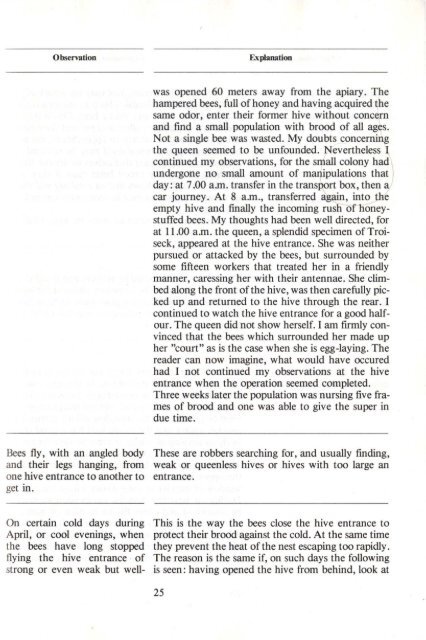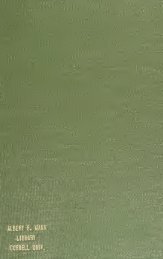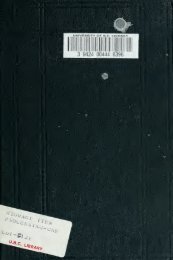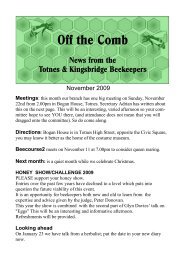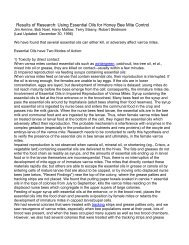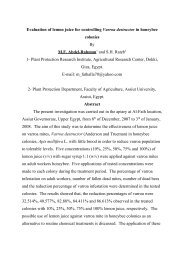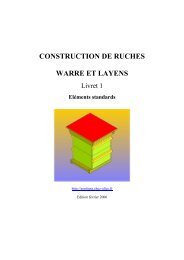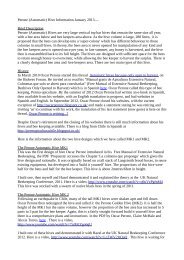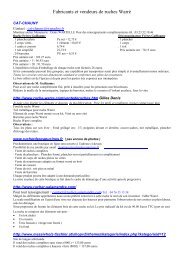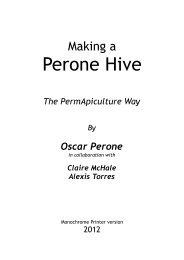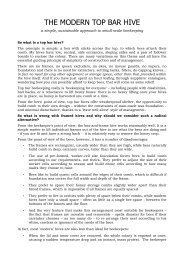You also want an ePaper? Increase the reach of your titles
YUMPU automatically turns print PDFs into web optimized ePapers that Google loves.
Observation<br />
Explanation<br />
was opened 60 meters away from <strong>the</strong> apiary. The<br />
hampered bees, full of honey and having acquired <strong>the</strong><br />
same odor, enter <strong>the</strong>ir former hive without concern<br />
and find a small population with brood of all ages.<br />
Not a single bee was wasted. My doubts concerni~g<br />
<strong>the</strong> queen seemed to be unfounded. Never<strong>the</strong>less I<br />
continued my observations, for <strong>the</strong> small colony had )<br />
undergone no small amount of maqipulations that<br />
day: at 7.00 a.m. transfer in <strong>the</strong> transport box, <strong>the</strong>n a<br />
car journey. <strong>At</strong> 8 a.m., transferred again, into <strong>the</strong><br />
empty hive and finally <strong>the</strong> incoming rush oChoneystuffed<br />
bees. My thoughts had been well directed, for<br />
at 11.00 a.m. <strong>the</strong> queen, a splendid specimen of Troiseck,<br />
appeared at <strong>the</strong> hive entrance. She was nei<strong>the</strong>r<br />
pursued or attacked by <strong>the</strong> bees, but surrounded by<br />
some fifteen workers that treated her in a friendly<br />
manner, caressing her with <strong>the</strong>ir antennae. She climbed<br />
along <strong>the</strong> front of <strong>the</strong> hive, was <strong>the</strong>n carefully picked<br />
up and returned to <strong>the</strong> hive through <strong>the</strong> rear. I<br />
continued to watch <strong>the</strong> hive entrance for a good halfour.<br />
The queen did not show herself. I am firmly convinced<br />
that <strong>the</strong> bees which surrounded her made up<br />
her "court" as is <strong>the</strong> case when she is egg-laying. The<br />
reader can now imagine, what would have occured<br />
had I not continued my observations at <strong>the</strong> hive<br />
entrance when <strong>the</strong> operation seemed completed.<br />
Three weeks later <strong>the</strong> population was nursing five frames<br />
of brood and one was able to give <strong>the</strong> super in<br />
due time.<br />
Bees fly, with an angled body These are robbers searching for, and usually finding,<br />
and <strong>the</strong>ir legs hanging, from weak or queenless hives or hives with too large an<br />
one hive entrance to ano<strong>the</strong>r to entrance.<br />
get in.<br />
On certain cold days during This is <strong>the</strong> way <strong>the</strong> bees close <strong>the</strong> hive entrance to<br />
April, or cool evenings, when protect <strong>the</strong>ir brood against <strong>the</strong> cold. <strong>At</strong> <strong>the</strong> same time<br />
<strong>the</strong> bees have long stopped <strong>the</strong>y prevent <strong>the</strong> heat of <strong>the</strong> nest escaping too rapidly.<br />
flying <strong>the</strong> hive entrance of The reason is <strong>the</strong> same if, on such days <strong>the</strong> following<br />
strong or even weak but well- is seen: having opened <strong>the</strong> hive from behind, look at<br />
25


